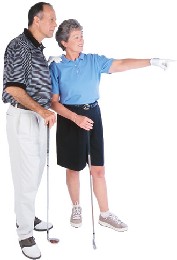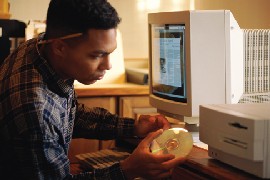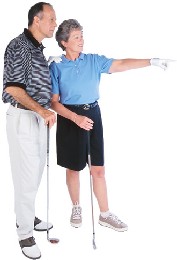When asked to discuss a memorable case of matching a pair of ophthalmic lenses to a patients lifestyle, optometrist Carl Gaterbaum of Orlando Eye Associates fondly recalls the case of Bobby, a 10-year-old boy who was transformed from a poor student into a successful one.
When he came to see me, he was having difficulty concentrating and comprehending while reading, and he had some visual perception problems, Dr. Gaterbaum remembers. The child had previously been fit with a pair of bifocals, but due to constant harassment by his peers about the line in the lens, he refused to wear them. In addition to that, the positioning of the bifocal line caused him to want to look over the near add or remove his glasses.
Each of these patients has a unique lifestyle to consider when presenting spectacles.




Dr. Gaterbaum fit him with progressive lenses and scheduled a work-up for Bobbys visual perception problems. Three months later, the parents said Bobby was doing 1,000 times better and started to enjoy reading. They wanted to cancel the visual perception work-up. The progressive not only removed the stigma of the bifocals and the annoyance of the line, but they also provided him with the ability to comprehend while reading, instead of just concentrating on keeping the words clear, Dr. Gaterbaum says.
Bobbys success illustrates the im-portance of prescribing lenses that not only match the patients prescription but his or her lifestyle needs. Here, several optometrists discuss the lifestyle issues their patients deal with and how these issues influence what type of lenses they recommend.
Progressive Lenses
Because progressive lenses do the work of both a bifocal and trifocal, minus the lines, they have become extremely popular for both presbyopes and emerging presbyopes who are involved in a number of occupations and hobbies. But, as Dr. Gaterbaum showed in the case with Bobby, baby boomers arent the only patients to take advantage of progressive lenses. Children have also been reaping the benefits.
In fact, Indianapolis optometrist Gregg Ossip prescribes progressives for young exotropic patients (ages 3 to 10). In the old days, we use to put exo-tropic kids in line bifocals to reduce the stress on their eyes, he says. But today, for cosmetic reasons, our generation doesnt want our kids walking around with a line on their lenses and neither do the kids themselves. Progressives are perfect for solving both problems.

Computer Vision Syndrome (CVS) is reaching epic proportions, but computer lenses can help.
Dr. Ossip says he also has begun prescribing progressive lenses for twenty- and thirtysomethings who have high focusing demands, probably because of computer use. They like the fact that progressives mimic natural vision, he says.
Computer Lenses
According to Personal Computing Environments, a company that re-designs the personal workspace (www.mypce.com/), 90% of all U.S. office workers use computers; 40% of these employees work on their computers at least four hours a day. Also, 51% of U.S. households had one or more computers in 2000, according to the U.S. Census Bureau. No wonder so many patients present with the eye strain, fatigue, light sensitivity, blurred vision, headaches and other signs and symptoms of computer vision syndrome (CVS).
One option might be a modified progressive, in which the patient looks through the top of the lens at the computer and the bottom when reading. That way, presbyopic patients dont have to tilt their heads and experience neck and back pain.
However, San Diego optometrist Eric White finds that a modified progressive lens is limiting. In a progressive modified, you have a wide intermediate, but as you look down, it gets narrower. So, if youre looking at your desk, you still really have to find your zone, he says.

Children with reading problems have also been reaping the benefits of progressive lenses.
Because of this limitation, Dr. White recommends a progressive computer lens, which he says offers a much wider field of vision. This, in turn, causes less of a strain on the eye. This strain is what leads to the other symptoms of CVS. When your eyes strain, they become tired, and you stare at the computer to clear it up, he says. When you stare, youre not blinking, so your eyes are going to burn and then water to try and compensate, and now youve got blurry vision.
For non-presbyopic patients who present with CVS, optometrist Clark J. Jensen of Grinnell, Iowa, recommends single-vision lenses with an anti-reflective (AR) coating. For example, he sees college students who spend much time on the computer, doing both their school work and playing games. Since I see a lot of eye strain, fatigue and blur, Ill recommend a single vision lens with AR coating because even small prescription needs are aggravated by computer work, he says. The AR coating eliminates the computers reflection on both the front and back of the lens, making it more comfortable.
Polycarbonate Lenses
Because polycarbonate lenses are thin, light and impact resistant, optometrist Corinne Odineal of Auburn, Calif., recommends them to her patients who participate in sports. In a sport like basketball, for instance, where people get fingers in their eyes, these lenses are not only not going to break, but theyre going to pop forward instead of inward, if placed in a sports frame, she says.
Dr. Odineal also recommends polycarbonate lenses to parents and their children because of their safety features.
The downside to polycarbonates? When you go into higher-powered lenses, what happens is you get different aberrations, and the lens gets thicker, she says. Children tend to be more adaptable than adults for the most part, so if you take an adult that has a higher-powered lens, putting them in a high-index lens may be better because it has less distortion than a polycarbonate.
Optometrist Robert M. Cole III of Bridgeton, N.J., says that while the newer versions of polycarbonate lenses have significantly reduced such problems, he would still advise reviewing these possible optical problems with patients who require higher prescriptions, prior to dispensing. Its important to do this, so that these patients will know that what they are experiencing is normal and will eventually resolve, he says.
Photochromic Lenses
Dr. Jensen recommends photochromic lenses such as
Transitions to patients who are farmers and garden enthusiasts because the lenses provide clear vision indoors, darken when exposed to sunlight and protect the eyes from UV rays. Farmers and people who enjoy gardening are indoors and outdoors so much that they like the ability of the lenses to change, he says. And, because they are exposed to more ultraviolet light than people in indoor occupations, the ultraviolet protection is a huge benefit because it reduces the amount of pterygia and cataracts.

Since basketball players and other athletesexperience a lot of physical contact, polycarb-onate lenses are suggested.
Dr. Gaterbaum recommends photochromic lenses to his male patients who find the need to carry extra pairs of eyewear to be extremely annoying. Men dont want to carry an extra pair of glasses in their pocket, whereas women can keep them in their purses, he says. But, with photochromic or transitional lenses, they have this one pair that meets all of their vision needs.
Optometrist Mitch Martin of Hood River, Ore., says that he has seen an increase in the popularity of Transitions and other photochromic lenses in the last year. A lot of my patients have become health conscious, expressing concern over macular degeneration and the other vision problems that can come about as a result of their eyes being outdoors, he says.
But, these lenses may not be appropriate for every patient. Although photochromic and transitional lenses are more convenient, they do not reduce glare as well as a polarized lens, so I would not recommend these lenses to patients who are very sensitive to the sun, Dr. Cole says.
Also, because ultraviolet light activates photochromics, Dr. Jensen does not recommend these lenses for driving. The wearer would not get enough direct sunlight to activate them, due to their cars windshield. He also does not recommend these lenses for night wear because they have a slight tint, which could disrupt the wearers vision.
Polarized Lenses
Optometrist Robert Ryan of Rochester, N.Y., recommends polarized lenses to patients who spend much time near ponds, lakes and any other bodies of water. Because they filter out the glare from the sun hitting the waters surface, they allow my patients to actually see into the depth of the water, he says. O.D.s often prescribe polarized lenses for the outdoor sports enthusiast.
However, Dr. Martin is hesitant to recommend them for skiers or golfers because they make reading the terraina necessity for both sportsextremely difficult. A lot of times your golfers want almost shooters vision. They want to be able to see that little white medium on the green, so you want to use an amber sunglass for that, he says. With skiers, you want to go with a darker-color sunglass because you have this bright white glare, and you want to reduce that, so they can still make out ice patches and moguls.
Dr. Jensen suggests polarized lenses for patients who do a lot of driving because glare can also be a major vision issue when theyre on the road. Polarized lenses eliminate the reflections off the dashboard, off of the inside of the windshield and from the cars you are sharing the road with, he says. The funny thing is, while you dont notice any of the glare while theyre on, when you take them off, you notice all of it. So, its one of those benefits you dont really appreciate until you go without it.

Since golfers often want shooters vision, amber sunglasses are recommended.
Non-RX Sunglass Lenses
Dr. Gaterbaum suggests sunglasses to his pediatric patients, given that damage to the eye from ultraviolet light accumulates from a persons entire life spent outdoors. When patients start to have cataracts at age 50 or 60, its not from what theyve done over the past few years. Its from what theyve done since they were a child, he says. And since you tend to be outdoors more when youre growing up, thats when we recommend it.
High-Index Lenses
Dr. Gaterbaum recommends high-index lenses to patients who have a prescription of 3.00D or higher, yet prefer a thinner lens for cosmetic reasons. High-index lenses allow patients who previously would not wear their glasses socially to be able to do so, he says.
Patients occasionally complain of distortion in going from their habitual lenses to high index. As optometrists, we must educate the patient about any symptoms they may experience during their adaptation to their new glasses, so they know it is temporary, he says.
Aspheric Lenses
Dr. Jensen recommends aspheric lenses to his fashion-conscious patients who have large amounts of hyperopia. The aspheric lens design cuts the thickness and therefore the magnification effect of the lens, which can initially disturb a patients depth perception, he says. So, the patient sees a bit better with those. And when people are looking at them, there is no bug-eyed [the patients eyes do not look gigantic] effect.
Tinted Lenses
New York optician Megne Yong recommends tints for patients who are into fashion and who
are looking for a polished and professional look. Some people choose to put a shadow tint with a very pale color lens to provide a smoky look, while others will go with a variety of colors to match certain outfits, she says.

According to one optician, her fashion-conscious patients buy shadow tinted lenses to match certain outfits.
Optometrist Michael Burke of Winston Salem, N.C., sees several motorcycle enthusiasts who also enjoy tinted lenses. A lot of times, they ask for vermilion or calichrome lenses to help them see better at dusk and dawn, he says. They feel it really enhances their enjoyment of the activity.
Optometrists and opticians must be astute in asking about both the environment of the patient and the patients style, because these two factors play as much of a role in the success of a patients glasses as their prescription does. In addition, optometrists and opticians must also be committed to working with the patient until theyve found the right lens or combination of lenses. The lens should fit the patient, not the patient fit the lens, points out Dr. Gaterbaum.

